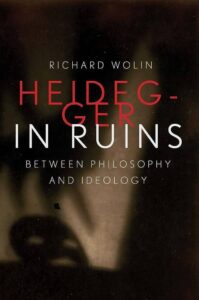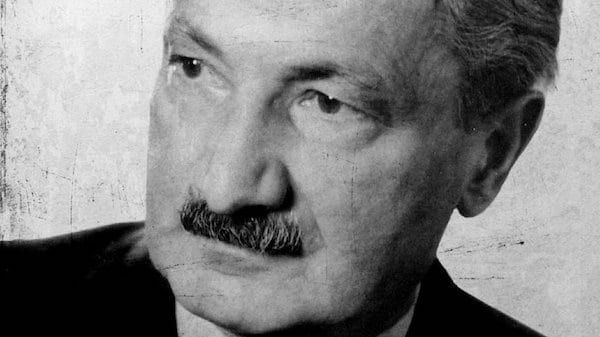The philosophical community knows by now that philosopher Martin Heidegger was fiercely antisemitic and personally drew connections between his philosophy and his support for Nazi ideology. The posthumous publication of Heidegger’s Black Notebooks beginning in 2014 made this much more apparent. The delayed publication was Heidegger’s own decision, likely in the belief that future generations would be amenable to the views expressed in them. In the Black Notebooks, we meet a Heidegger who claims that Jewish scheming corrupted Western metaphysics, reducing it to ‘empty rationality and calculability’ and arguing for the ‘total extermination’ of the Jewish people (188).

Richard Wolin: Heidegger in Ruins: Between Philosophy and Ideology
Yale University Press, New Haven, 2022. 488 pp., $35.34 hb
ISBN 9780300233186
In Heidegger in Ruins, Richard Wolin contends that responses to the publication of the Black Notebooks have failed to take full account of this information. Some philosophers’ responses have included abysmal denials and minimizations, as well as simply prescribing a solution of ‘more Heidegger,’ hoping to use Heidegger’s philosophy against his politics without reckoning with his own linkages between the two.
Meanwhile, Heidegger’s work influences today’s resurgent fascist movements, as Wolin explores in one of the book’s chapters. Heidegger is lauded and read by many across today’s far-right, influencing the French New Right’s ‘metapolitics’ and Russia’s Aleksandr Dugin, Martin Sellner’s ‘Identitarian’ movement and alt-right fascist websites in the United States. Former Trump administration member and far-right networker Steve Bannon even called Heidegger ‘my guy.’
Wolin shows that Heidegger’s antisemitism and fascist affinities are long running in his intellectual trajectory, before, during and after World War II. Wolin also demonstrates that this has been systematically buried, including by Heidegger’s literary estate, which produced ‘politically sanitized versions of Heidegger’s texts,’ including removing endorsements of Hitler and Mussolini (27).
We can begin by addressing the through-lines of Heidegger’s fascist affinities before, during and post-World War II. Then to be addressed are the three interlocking themes that Wolin sees in Heidegger’s work connected to his antisemitism and fascist affinities: Heidegger’s views on race, work and land.
After World War I, Heidegger blamed the economic crisis on the Jews and romanticized war, influenced by Ernst Jünger’s militaristic celebration of the ‘spirit of the Front’ [Frontsgeist]. Heidegger was also influenced in this period by the ‘conservative revolution’ of Oswald Spengler, Ernst Jünger and Carl Schmitt, as well as drawing from Nietzsche an embrace of ‘active nihilism.’ Heidegger had affinities with Jünger’s ‘National Bolshevism’ and the ‘Strasserite’ faction of National Socialism, a branch of fascism that particularly emphasized the ‘worker’ and social benefits for those it deems worthy, while also advocating authoritarian nationalism and racist hierarchy (179).
By at least 1929, Heidegger was becoming ‘increasingly disturbed by [what he called] the “Jewification of the German spirit”’ (268). Between 1928 and 1933, he was friends with future Nazi propagandist Alfred Baeumler, and suggested Baeumler as successor for his philosophy chair at University of Marburg. In 1931, Heidegger enthusiastically praised Mein Kampf as crucial for understanding ‘what is at stake is the redemption or destruction [Rettung oder Untergang] of Europe and Western culture’ (70).
Another important influence on Heidegger addressed by Wolin is the Stefan George Circle, a cultish group of avant-garde protofascist writers and poets who saw themselves as the keepers of a ‘Secret Germany.’ Heidegger was influenced by and praised a number of works of the George Circle and spoke similarly of Germany’s ‘secret mission’ (73). Relatedly, Heidegger was fascinated by the contemporary debate on nineteenth century thinker J.J. Bachofen, who had argued that patriarchal societies were preceded by a lost matriarchal past of unity between humans and nature. While Bachofen’s theory of prehistoric matriarchy had interested Friederich Engels for its potential use in a critique of capitalist patriarchy, the reactionaries of Weimar Germany were drawn to Bachofen because they sought a ‘primal past’ free of the Enlightenment, democracy and modern rationality. Among the reactionaries using Bachofen in this way were another figure in the George-Kreis, Ludwig Klages, along with Alfred Baeumler.
After being appointed Rector of the University of Freiburg under Hitler, Heidegger not only immediately joined the Nazi party (NASDP) in 1933, but also enthusiastically pushed the University of Freiburg further right, embracing a vision of students as nationalistic ‘workers.’ As Führer-Rektor, Heidegger ‘comported himself as a committed political radical: a Nazi true believer’ (100). Heidegger pushed for more racist policies, including expelling Jewish faculty earlier than required and establishing pseudo-scientific race studies at the university.
During World War II, Heidegger believed that England, the United States and Russia were pawns of ‘world Jewry,’ and that the ‘redemption’ of the West depended on the Germans who alone had access to the hidden ‘truth of Being’ (156-157).
After the war, Heidegger felt he had nothing to apologize for, engaged in Holocaust denial and insisted to Karl Jaspers that ‘there really is a world conspiracy of Jews’ (182). To the extent that Heidegger retreated from politics after the war—it becomes clear on Wolin’s account—he retreated not because he was sorry, but because he had lost.
However, Heidegger’s strategic retreat was not total. Rather than abandoning the sphere of the political, Heidegger in his writing and public speaking pursued ‘metapolitical’ ends, seeing politics as downstream of culture. In fascist Julius Evola’s terms, it could be pointed out that after the Nazi defeat, Heidegger was ‘riding the tiger’: straddling modernity and hoping to strangle it at a future time.
Even Heidegger’s core concept of Dasein is embedded in this racist philosophy. Adorno (in The Jargon of Authenticity) and Marcuse had previously drawn connections between Dasein’s ‘being towards death’ and fascism, as Wolin points out (129). Wolin’s work makes this tie harder to ignore. Heidegger wrote of a ‘collective Dasein’ formed through shared ‘folk songs, folk festivals, and customs,’ through establishing dwellings and through making its ‘imprint on the land’ (147). Not every Volk has a collective Dasein, according to Heidegger.
According to Heidegger, Jews lacked life, roots, history, knowledge [Erkenntnis] and world. Heidegger viewed Jews as cunning and parasitical, and classified them together with Slavs and Blacks as a ‘nonhistorical people’ and having ‘forfeited their “right to exist”’ (154, 258). Since the Jews had outlived their opportunity for usefulness, they could be eradicated without compunction. Furthermore, Heidegger posed Jews as a threat, referring them as ‘anti-Christ,’ ‘anti-matter’ and a ‘principle of destruction’ (259). By contrast, non-Jewish Germans were ‘the most endangered Volk […] the most metaphysical Volk’ (270).
Although Wolin shows that Heidegger did have an interest in ‘race science’ as Rector, he also rightly points out that Nazi racism was not just biological; Heidegger’s racism is likewise ‘spiritualized.’ Wolin shows the parallels specifically with Italian fascist Julius Evola, who was embraced by Nazi Germany. Like Heidegger, Evola ‘spiritualized’ his racism and had ‘a Gnostic understanding of Western modernity as a “site of catastrophe”’ (161).
With regard to work, Wolin stresses the Nazi emphasis on ‘camps’ [Lager], not only death camps but also work camps and war-like training camps for youth and various professions. Heidegger advocated, for example, that professors receive training in ‘camps.’ Ernst Jünger moved from this enthusiasm for ‘total war’ to ‘total mobilization,’ expressed in mass formation of ‘camps.’ Jünger, who supported Hitler, made possible the conceptual linkages between work and mobilization that paved the way for Nazi propagandist Goebbels’ appeal for a ‘steely romanticism,’ that would overcome the ‘soullessness’ of technology (steel) through romantic nostalgia (187, 195-196).
Heidegger’s thinking on space and land was influenced by antisemitic nationalist writers and sought access to a ‘primal past’ (294). Here Heidegger is influenced by Hölderlin’s ‘aesthetic state,’ and we can also see this in his challenge to the Enlightenment rationalism of Cassirer, as Wolin points out. Heidegger ultimately embraced an ‘actively nihilistic’ mythos against rationality and modernity. The need to clear away and make more room [Raum] on the land through work [Arbeit] connects in Heidegger to an apocalypticism that Wolin references using the term ‘accelerationism’ (66). This term, popularized by far-right philosopher Nick Land, has become a bit of an overused buzzword in the world of ‘counter-extremism’ think tanks, where it is used to describe both revolutionary and reactionary social movements. But the concept is relevant here, as a way of expressing the belief that destructiveness should be embraced for its cleansing power, a core tenet of fascist ideology. Fascism is palingenetic (according to the famous definition by Roger Griffin) and has a cyclical vision of history, desiring the destruction and rebirth of the world to restore past hierarchies. Heidegger’s celebration of ‘extreme, active, space-producing nihilism […] ecstatic nihilism’ (191-192) is of a piece with his vision of the crucial role of Arbeit (including the Arbeit of the German militarized worker-students) as opening up space, clearing (199). Untergang (or decline) should not be feared, Heidegger argued—rather, ‘to offset […] rootlessness’ humanity should welcome a ‘purification of Being from the predominance of “beings,”’ through the coming ‘self-obliteration of the earth and the disappearance of contemporary humanity’ (168).
Two other recent English language books have argued strongly for an interpretation of Heidegger’s philosophy as deeply entwined with antisemitism and fascist politics: Adam Knowles’s Heidegger’s Fascist Affinities: A Politics of Silence and Ronald Beiner’s Dangerous Minds: Nietzsche, Heidegger, and the Return of the Far Right. Both are important contributions, yet both need to be supplemented by Wolin’s extensive research in Heidegger in Ruins. Discussing Heidegger’s antisemitism among academic philosophers has sometimes been, if not completely taboo, seen as uncouth, or dismissed as ‘empirical,’ ergo not ‘philosophical.’ In recent years, it has become ever more apparent that we ignore fascist ideology at our peril. While we should not take expression of genocidal sentiments seriously as rational arguments, we do need to take them seriously as impactful, needing to be combatted and requiring drawing boundaries of acceptability. Philosophers need to be alert to the far-right’s uptake of Heidegger and attuned to what invocations of Heidegger can imply. None of this is to say that no one should read or employ Heidegger’s works (something Wolin has also never claimed in this or previous works), but we must normalize meaningfully addressing the nastier aspects.
Although more extensive and drawing on newly available materials, Heidegger in Ruins also reiterates some claims that Wolin has made in earlier works at a time when pointing out likely connections between Heidegger’s Nazism and his philosophy was reputationally riskier for academics. Amidst rising fascist movements globally and Heidegger’s continued influence on the far-right today, if some readers feel like Wolin is saying “I told you so” in the new book, Wolin has earned that right.
Joan Braune, Ph.D., is Lecturer in Philosophy at Gonzaga University. She is author and co-editor of various titles, including two books on Erich Fromm’s critical theory, and two forthcoming books on contemporary fascist movements and the ethics of researching far-right movements.

